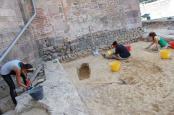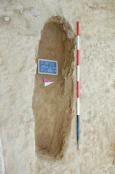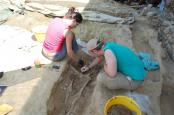CAMPAGNA 2012 |
1° SETTIMANA |
2° SETTIMANA |
3° SETTIMANA |
4° SETTIMANA |
5° SETTIMANA |
6° SETTIMANA |
26 LUGLIO 2012 
Resoconto della giornata di scavo
Area 1000
Dopo la rimozione dello scheletro US 1508, che adesso sappiamo essere un maschio adulto deposto in fossa terragna, continua lo scavo dello strato limo argilloso US 1502 per evidenziare il livello sottostante caratterizzato dalla presenza di alcuni tagli e chiazze scure da documentare ed esplorare. È stata inoltre messa in luce una buca circolare a sud della struttura muraria US 1008, forse in fase con le buche già individuate la scorsa stagione.
Today in area 1000, we finished removing a layer of compact clay in the southeastern corner. The area in the western half was leveled and cleaned. Later in the day, this newly expanded area 1500 was sprayed down to reveal the differences in soil composition. The individual 1508, located in the burial within 1500 was fully removed. Photographs were then taken of the cut underlying the skeletal remains, as well as the fill located along the southern wall.
Area 2000
Oltre alla prosecuzione della messa in luce dell’individuo Us 2247, nella porzione centrale del Settore A, è proseguita l’indagine dei diversi tagli individuati presso il Settore B. All’interno di US -2249, presso l’angolo Sud orientale, è stata appurata la presenza di due individui giovanili sepolti probabilmente nello stesso momento, in quanto si presentano posizionati con orientamenti opposti (Sud-Nord e Nord Sud) e l’uno sopra l’altro. Il più superficiale presenta una placca in bronzo al livello del bacino. Inoltre, all’interno del riempimento (US 2251) sono stati rinvenuti alcuni spilli bronzei, frammenti ceramici medievali e placche metalliche. Il taglio US -2253 risulta perfettamente allineato all’altro posto subito ad Ovest; la rimozione del riempimento ha permesso la messa in luce di uno strato di calce al di sotto del quale sembrano apparire una ulna e un omero in connessione. La presenza della calce e la volontà di seppellire due individui giovanili all’interno della stessa fossa sepolcrale fanno, ad ora, pensare ad un evento epidemico di epoca medievale. Nella porzione più centrale è stato indagata l’US -2257 che risulta un taglio di fossa sepolcrale per l’inumazione di un infante orientato SO/NE.
A great deal of progress was made today in area
2000. Alexa and Adam continued the excavation of skeleton 2247 in sector A. The
grave is oriented East West and thr individual lacks a cranium. The tibia is
rotated laterally and we are still working to determine the exact position of
the right foot. The left hand is articulated and well preserved while the right
hand is poorly preserved. Beneath the pelvis other bones were found that are
not in connection (the meaning and exact placement of the bones is yet to be determined).
Today Walker continued excavating fill US 2253 that was visible in Sector B
after yesterday's work. Walker was searching for the bottom limits of the cut
when he uncovered a layer of mortar. Beneath the mortar a distal humerus and
proximal ulna in articulation. Pictures an altitudes were taken of the cut. A
possible explanation for the mortar covered burials is that an infectious
disease killed the individuals and their bodies were covered in mortar in an
attempt to prevent disease transmission. In the afternoon Molly continued
excavating the fill 225 1which contains at least two sub adult individuals. It
appears that the graves were cut when the grounding wire for the church was
installed. The younger individual, with whom a belt buckle was found in association,
overlies the second individual.
Veronica began excavation on what was predicted to be a burial. Within the full
Veronica found pottery and at 3-5 cm deep, found a sub adult cranium. The
pottery is believed to be of a relatively recent date and the vessel was
probably used as a cup for water.
Claire continued her work in the osteo lab today.
Area 3000
La pulizia del Settore B ha permesso di individuare e mettere in luce un nuovo individuo ( US 3200) ricollegabile alla fase cimiteriale sette-seicentesca. L’inumato, ad una prima osservazione una femmina adulta, si presenta in buono stato di conservazione, è deposto supino ed orientato N-S, immediatamente a S-W del muro US 3073 e risulta privo del cranio, probabilmente asportato in seguito ad uno scasso effettuato nella struttura muraria per recuperare le pietre migliori. Le braccia sono entrambe flesse sul torace e le mani sono in atteggiamento di preghiera; gli arti inferiori sono distesi e simmetrici, con le ginocchia convergenti ed i piedi sono mal preservati. Lungo il muro è stata inoltre scavata una buca ( US -3204) molto profonda, di forma circolare, realizzata probabilmente per ospitare un palo di legno, ormai decomposto. Continua inoltre l’indagine all’interno della cassa litica: la rimozione dell’individuo infantile US 3183 ha permesso la messa in luce completa della femmina adulta US 3191, deposta in decubito dorsale immediatamente al di sotto del bambino, con il braccio sinistro appoggiato sul coxale ed il destro disteso lungo il corpo. Domani, nel corso della giornata, si procederà con la rimozione dell’inumata e la messa in evidenza delle ossa ridotte per favorirne la deposizione.
Today Emilia and Frank excavated the lithic tomb. The child was removed and the adult, most likely the mother, was cleaned and removed at the end of the day. During removal, the child's mandible was discovered under the adult maxilla. Heather and Amanda worked on the skeleton from yesterday in sector B of the area. The skeleton was cleaned and removal will take place tomorrow. Heather was also in the pottery lab for half of the day. Emma uncovered the hole in the wall and found a post hole in which bones and pottery were found. She the volunteered to help I the bone lab. Michael worked on GIS all day.
Area 4000
Lo scavo dei giorni precedenti ha permesso di mettere in
luce diverse situazioni stratigrafiche di notevole interesse per l’intera area.
Nel settore A sono state messe in luce, documentate e fotografate quattro nuove
UUSS, successivamente iniziate a rimuovere : US 4097 ed US -4099
(un taglio ed il suo riempimento a ridosso della struttura US 4063,
situazione nella quale sono state rinvenute delle tracce osteologiche che lo
scavo dei prossimi giorni confermerà o meno far parte di una sepoltura), US
4098 ed US -4100 (una buca sita nella parte centro meridionale del
settore, il cui riempimento era composto da pietre di grosse dimensioni tra cui
quello che sembra essere una porzione di pila per l’uso dell’acqua. Sul fondo
del riempimento è stato inoltre rinvenuto un frammento di laterizio recante
un’impronta di zampa di cane, relativa probabilmente alla fase di asciugatura
del laterizio al momento della sua realizzazione). Nel settore B è stata invece
messa in luce US 4091 ed il suo taglio US -4101, realizzato
anch’esso a ridosso di US 4063 ma sul lato opposto, quello orientale. Si
trova comunque alla stessa altezza di US 4097 ed US -4099. È
stata inoltre iniziata la rimozione di US 4093, uno strato argilloso caratterizzato
dalla alta concentrazione, in esso, di lastre di ardesia relative alle
coperture degli edifici. L’importanza di questo strato è la sua posizione al di
sopra della rasatura della struttura US 4063, US 4088. Sarà
inoltre significativa la sua rimozione, lettura e pulizia poiché si tratta del
primo strato che collega i due settori (A e B) fino ad ora riconosciuti e
separati dalla suddetta struttura US 4063.
Today on July 26 in Area 4000, we evened out
the surface of section A, 4092, and finished cleaning 4095 and 4096. We also
investigated the limits of the wall and found the limit of 4093 that contains a
context of mortar and slate. We cleaned to reveal more stone from the structure
of 4098. This small round rock formation is man-made and puzzeling. We will
continue to discover its meaning. After cleaning we took pictures of each
context and we plan to remove them to find new layers.
















